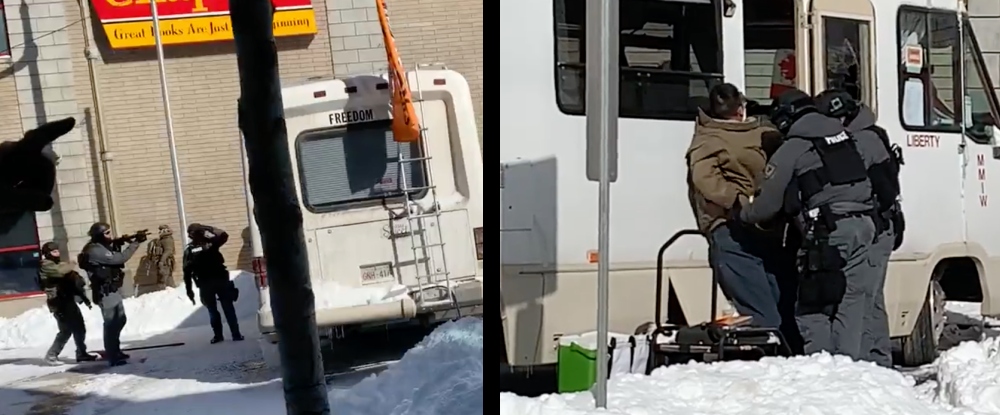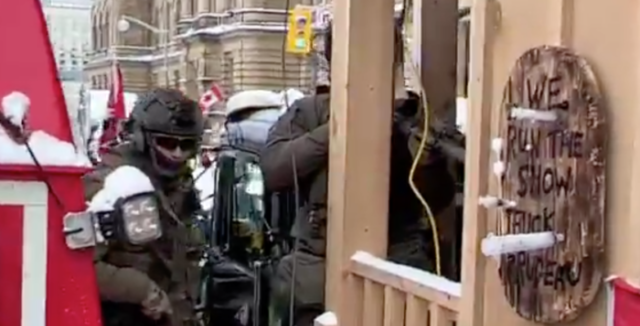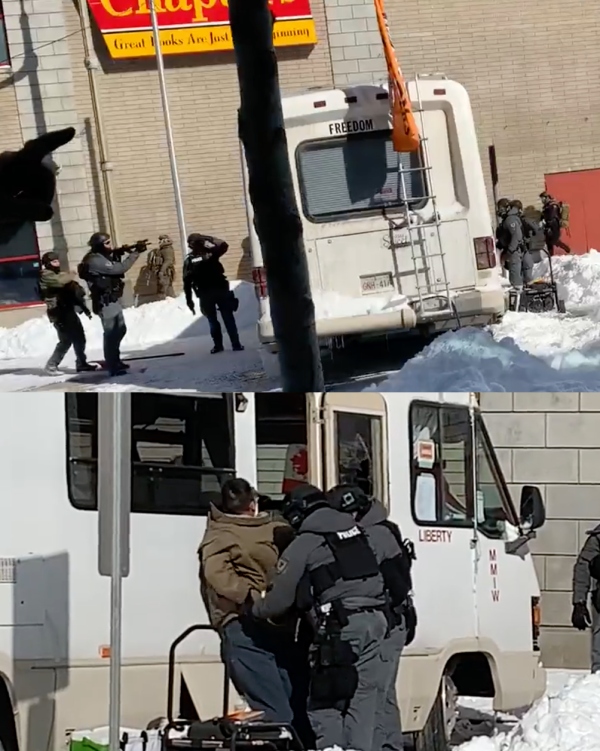
The New York Times reported last weekend that police in Ottawa had arrested protesters at gunpoint, a claim that was quickly challenged and denounced by prominent Canadian journalists.
“This is wrong,” tweeted freelance reporter Justin Ling, who had been covering the police action from Ottawa. CBC News TV host Ginella Massa called the Times headline “false and incredibly dangerous rhetoric” and CBC radio host Piya Chattopadhyay asked “where are you getting this bs from?”.
Is the @nytimes drunk? Where are the guns? Look, Ottawa police have not covered themselves in glory here but what they are doing is not “at gunpoint”. Who is behind the wheel at NYT Canada? pic.twitter.com/iAjja5zNbG
— Stephanie Carvin (@StephanieCarvin) February 19, 2022
Narwhal climate reporter Fatima Syed, who is also the Vice President of the Canadian Association of Journalists and host of the Canadaland podcast The Backbench, called the Times story “embarrassing and wrong.” Journalists from The Globe and Mail, Global News, and more also criticized the Times, some demanding a correction.
“Maybe leave the gossip to the “professionals”,” remarked society writer Shinan Govani.
Yet truckers were indeed arrested by police in Ottawa at gunpoint, says New York Times reporter Sarah Maslin Nir, who shares a byline on the contested piece with colleague Natalie Kitroeff.
“We saw these [arrests] transpire first hand,” Maslin Nir told Canadaland via Twitter DM, “and in addition have multiple interviews from people this happened to, including David Paisley, quoted in the article…what really is blowing my mind is the wave of JOURNALISTS saying we didn’t see what we saw.”
Maslin Nir referred Canadaland to a video of police officers with military assault rifles, one of them raised, entering the structure in which Paisley said he was arrested by an officer who aimed a rifle at his chest.

Canadaland asked The Ottawa Police Service if arrests were indeed made at gunpoint, or if they challenge the New York Times’ account. Constable Paramjit Singh wrote back from the service’s Media Relations office with the following statement:
“There was a police operation on Wellington Street in the morning of February 19th regarding suspected explosives believed to be located in a vehicle. Members of the Tactical Team were also at scene at the time of the arrest; and this Team has their carbines on them and visible at all times, as part of their equipment to be readily available for exigent circumstances such as this one.”
Rebukes of the Times’ report extended beyond journalism circles. “This headline is shit and irresponsible,” tweeted actor Jay Baruchel. CBC personality Dr. Brian Goldman called a Times tweet about arrests at gunpoint “reprehensibly inaccurate,” and Dr. David Fisman, also a fixture on CBC’s airwaves, asked his 112,000 followers if they could get the hashtag “#NYTUnsubscribe” to trend.
Can we get #NYTUnsubscribe trending?
— David Fisman (@DFisman) February 19, 2022
It soon did. Senator Paula Simons posted her opposition to the Times report in the form of an animated GIF, and Gerry Butts, former Principal Secretary to Justin Trudeau, also voiced his disappointment with the report.
In one instance, a journalist made their own error in an attempt to correct the Times.
CBC radio host Carol Off accused the New York Times of failing to send reporters to Ottawa for its coverage, in a tweet that was then shared over 3000 times.
Hey New York Times. If you don’t want to send reporters to the scene then all you have to do is watch Canadian TV. Try a bit harder to get the story right.
— Carol Off (@caroloffcbc) February 19, 2022
Yet Sarah Maslin Nir was one of four New York Times journalists reporting from the scene of the police action last weekend (the Times sent two reporters and two photojournalists). She directed Canadaland to a series of videos posted by Globe and Mail reporter Marieke Walsh on Friday, as independent confirmation that police had indeed raised their firearms when making arrests.
The videos, posted on the afternoon of Friday, February 19, show a police unit breaking into a camper van that was parked outside of a Chapters bookstore. Walsh reported that someone appeared to be inside the vehicle. An officer could be seen aiming his military rifle at the driver’s side window as another officer ushered Walsh and others away from the scene, yelling “Get back! Anything can happen right now!” A subsequent video, posted by Walsh two minutes later, showed police arresting the man who had been locked inside the camper van. Walsh identified him as Wayne Harvey, an Indigenous protester from the Esgenoopetitj First Nation (also known as Burnt Church) in New Brunswick. Walsh said she had interviewed him a day earlier.
“He told us that he was here to bring awareness to MMIWG and residential school survivors as well as anti-vaxx.”

The headline and copy of the controversial New York Times report changed throughout the weekend, leading many to conclude that the story was being quietly washed of errors without a formal correction being issued.
Maslin Nir says that these assumptions are false, and that the reason why no correction was issued by her editors was because her story is not incorrect.
“The reporting stands firmly,” she wrote.
As for the changes, Maslin Nir said “we constantly refresh update enrich and expand a story in real time when it is breaking news.” She explained that “the story that is put up at 10 AM in a breaking news situation…will be different than the one that goes to bed at the end of the day. That is intentional. We do at least three write-throughs throughout the day on these types of stories, pulling in more info and reports. So that explains why the story (or any breaking story) is different, several times. But if you will notice, the reporting about guns being drawn on protesters while making arrests, was not changed, in fact it was strengthened and underlined with the inclusion of an interview based on reporting later in the day from a person who experienced it THEMSELVES. That’s not a correction, that’s a confirmation.”
The New York Times coverage of the police sweep in Ottawa also produced a striking image of a police horse stepping on a protester as they lay on the street. Maslin Nir told Canadaland that she was surprised to find this account challenged by a commentator who, despite the photographic evidence, insisted that police horses had been trained to never step on people.
“I used to be a mounted officer,” wrote Maslin Nir, “They are not trained that way. It’s not possible.”
SIU Investigating Reported Serious Injury of Woman in Interaction with Police Horse, Less-Lethal Firearm Discharges at Ottawa Demonstrations
Witness? Contact us here: https://t.co/GKSIXZs3JB #ottnews @OttawaPolice https://t.co/qn2rz6J5cB
Francais: https://t.co/an2RR9ukid pic.twitter.com/ZJora8J4sr— Special Investigations Unit (@SIUOntario) February 20, 2022
Canadian journalists have expressed their admiration for the police action. Justin Ling described the relative lack of injuries as “incredible,” and praised the law enforcement operation as “the benchmark of how crowd control situations don’t need to be as violent and confrontational as they often are.”
Maslin Nir offered Canadaland a thought about the vehemence with which many Canadians insisted that her report was not true.
“I think we hit a hornet’s nest : Canada does not want to see itself this way.”